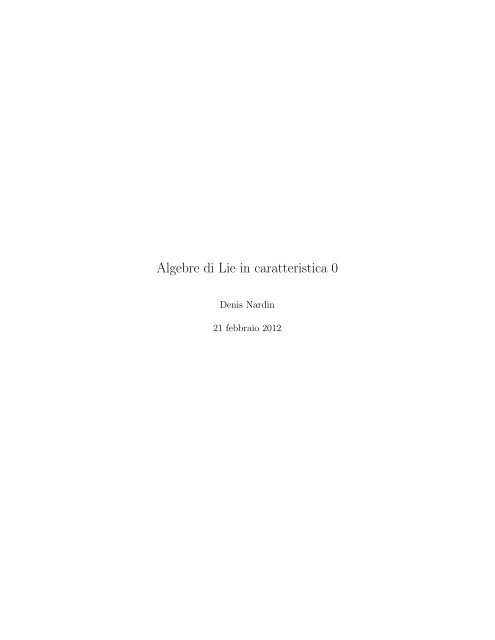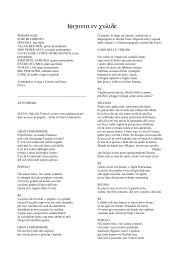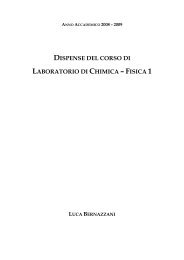Algebre di Lie in caratteristica 0
Algebre di Lie in caratteristica 0
Algebre di Lie in caratteristica 0
Create successful ePaper yourself
Turn your PDF publications into a flip-book with our unique Google optimized e-Paper software.
<strong>Algebre</strong> <strong>di</strong> <strong>Lie</strong> <strong>in</strong> <strong>caratteristica</strong> 0<br />
Denis Nar<strong>di</strong>n<br />
21 febbraio 2012
Capitolo 1<br />
Proprietà generali<br />
In questo sem<strong>in</strong>ario parlerò <strong>di</strong> algebre <strong>di</strong> <strong>Lie</strong> su <strong>di</strong> un campo k algebricamente<br />
chiuso e <strong>di</strong> <strong>caratteristica</strong> 0. In realtà non è davvero necessario richiedere che il<br />
campo sia algebricamente chiuso, tutto quello che <strong>di</strong>rò a parte un paio <strong>di</strong> lemmi<br />
varrà anche per campi non algebricamente chiusi e può essere ricavato da quel<br />
caso (usando astutamente la teoria <strong>di</strong> Galois). Tutti gli spazi vettoriali saranno<br />
f<strong>in</strong>ito-<strong>di</strong>mensionali salvo dove esplicitamente <strong>in</strong><strong>di</strong>cato.<br />
1.1 Sommario<br />
• Def<strong>in</strong>izione <strong>di</strong> algebra <strong>di</strong> <strong>Lie</strong>. Esempi (gl(V ), sl(V ), tn, un, l’algebra <strong>di</strong> <strong>Lie</strong><br />
<strong>di</strong> un’algebra associativa...)<br />
• Def<strong>in</strong>izione <strong>di</strong> rappresentazione <strong>di</strong> un’algebra <strong>di</strong> <strong>Lie</strong>. Esempi: rappresentazioni<br />
<strong>di</strong> def<strong>in</strong>izione, rappresentazione aggiunta. In gl(V ) ogni elemento<br />
nilpotente è ad-nilpotente.<br />
• Def<strong>in</strong>izione <strong>di</strong> algebra <strong>di</strong> <strong>Lie</strong> nilpotente. Teorema <strong>di</strong> Engel. Def<strong>in</strong>izione <strong>di</strong><br />
nilra<strong>di</strong>cale.<br />
• Def<strong>in</strong>izione <strong>di</strong> algebra <strong>di</strong> <strong>Lie</strong> risolubile. Proprietà elementari. Def<strong>in</strong>izione<br />
<strong>di</strong> ra<strong>di</strong>cale.<br />
• Def<strong>in</strong>izione <strong>di</strong> algebra <strong>di</strong> <strong>Lie</strong> semisemplice. [gg] = g (senza <strong>di</strong>mostrazione).<br />
1.2 <strong>Algebre</strong> <strong>di</strong> <strong>Lie</strong> e loro rappresentazioni<br />
Un’algebra <strong>di</strong> <strong>Lie</strong> su <strong>di</strong> un campo k è uno spazio vettoriale g con una mappa<br />
[, ] : g × g → g bil<strong>in</strong>eare tale che<br />
• [a, a] = 0 per ogni a ∈ g (cioè [, ] è alternante)<br />
1
• Vale l’identità <strong>di</strong> Jacobi:<br />
Un po’ <strong>di</strong> esempi <strong>di</strong> algebre <strong>di</strong> <strong>Lie</strong>:<br />
[a[bc]] + [b[ac]] + [c[ab]] = 0<br />
• Se V è uno spazio vettoriale f<strong>in</strong>ito <strong>di</strong>mensionale su k, gl(V ) è l’algebra <strong>di</strong><br />
<strong>Lie</strong> ottenuta prendendo come spazio vettoriale gli endomorfismi <strong>di</strong> V <strong>in</strong><br />
sè, e come bracket il commutatore<br />
[a, b] = ab − ba .<br />
Questo è <strong>in</strong> qualche senso l’esempio più importante. In<strong>di</strong>cheremo con<br />
gln(k) l’algebra <strong>di</strong> <strong>Lie</strong> delle matrici gl(k n ).<br />
• Se <strong>in</strong><strong>di</strong>chiamo con sl(V ) il sottospazio vettoriale <strong>di</strong> gl(V ) composto dalle<br />
matrici a traccia nulla abbiamo che è anche una sottoalgebra <strong>di</strong> <strong>Lie</strong>.<br />
• Il sottospazio <strong>di</strong> gln(k) composto dalle matrici triangolari superiori tn(k)<br />
è una sottoalgebra <strong>di</strong> <strong>Lie</strong>.<br />
• Il sottospazio <strong>di</strong> tn(k) composto dalle matrici strettamente triangolari<br />
superiori un(k) è una sottoalgebra <strong>di</strong> <strong>Lie</strong>.<br />
• Più <strong>in</strong> generale, se A è un’algebra associativa possiamo dare ad A una<br />
struttura <strong>di</strong> algebra <strong>di</strong> <strong>Lie</strong> prendendo come bracket il commutatore<br />
[a, b] = ab − ba .<br />
Questa è detta algebra <strong>di</strong> <strong>Lie</strong> associata all’algebra associativa A.<br />
Un ideale <strong>di</strong> un’algebra <strong>di</strong> <strong>Lie</strong> è una sottoalgebra I ⊆ g che assorbe il<br />
bracket. Si può quozientare per ideali (fai il quoziente come spazi vettoriali e il<br />
bracket passa al quoziente). Un esempio importante <strong>di</strong> ideale è l’ideale derivato<br />
[gg] def<strong>in</strong>ito da<br />
[g, g] = Span([xy] | x, y ∈ g) .<br />
Osserviamo che [gl(V ), gl(V )] = sl(V ) e che [tn(k), tn(k)] = un(k).<br />
Una rappresentazione <strong>di</strong> un’algebra <strong>di</strong> <strong>Lie</strong> g è uno spazio vettoriale V<br />
con un omomorfismo <strong>di</strong> algebre <strong>di</strong> <strong>Lie</strong> g → gl(V ). Esempi <strong>di</strong> rappresentazione.<br />
La rappresentazione aggiunta <strong>di</strong> un’algebra <strong>di</strong> <strong>Lie</strong> g è quella data<br />
dall’omomorfismo<br />
ad : g → gl(V ) ad(x) = [x·] .<br />
1.3 <strong>Algebre</strong> <strong>di</strong> <strong>Lie</strong> nilpotenti<br />
Un elemento x <strong>di</strong> g si <strong>di</strong>ce ad-nilpotente se ad x è nilpotente, ad-semisemplice<br />
se ad x è <strong>di</strong>agonalizzabile.<br />
2
Lemma 1. Per ogni x, y ∈ gl(V ) e per ogni i ≥ 1 vale<br />
(ad x) n y =<br />
n<br />
i=0<br />
<br />
n<br />
(−1)<br />
i<br />
i x i yx n−i .<br />
In particolare ogni elemento nilpotente è ad-nilpotente.<br />
Dimostrazione. Induzione su n, banale.<br />
Qu<strong>in</strong><strong>di</strong> ogni elemento nilpotente <strong>di</strong> gl(V ) è ad-nilpotente.<br />
Lemma 2. Sia g ⊆ gl(V ) una sottoalgebra <strong>di</strong> <strong>Lie</strong> composta <strong>di</strong> elementi nilpotenti.<br />
Allora esiste v ∈ V non nullo tale che gv = 0.<br />
Dimostrazione. Per <strong>in</strong>duzione su <strong>di</strong>m g. Infatti se <strong>di</strong>m g = 1 è ovvio. Pren<strong>di</strong>amo<br />
ora h sottoalgebra massimale <strong>di</strong> g. Allora h agisce <strong>in</strong> modo naturale sullo spazio<br />
g/h, per cui per ipotesi <strong>in</strong>duttiva (dato che <strong>di</strong>m h < <strong>di</strong>m g e ogni elemento <strong>di</strong> h<br />
è ad-nilpotente) abbiamo che esiste x ∈ g h tale che [hx] ⊆ h. Ma allora h ⊕ x<br />
è una sottoalgebra che contiene propriamente h, qu<strong>in</strong><strong>di</strong> è g. In particolare h è<br />
un ideale. Per ipotesi <strong>in</strong>duttiva<br />
W = {v ∈ V | hv = 0}<br />
è non banale. Inoltre xW ⊆ W con un rapido conto (h(xv) = [hx]v + x(hv) = 0<br />
per ogni v ∈ W ). Ma x è nilpotente, qu<strong>in</strong><strong>di</strong> ha il nucleo non banale. Perciò<br />
preso v ∈ W tale che xv = 0, da cui la tesi.<br />
La serie centrale <strong>di</strong> un’algebra <strong>di</strong> <strong>Lie</strong> è la successione <strong>di</strong> ideali<br />
g [0] = g, g [n+1] = [gg [n] ] .<br />
Un’algebra <strong>di</strong> <strong>Lie</strong> è detta nilpotente se g [n] = 0 per qualche n ≥ 0.<br />
Esempio: un(k) è nilpotente.<br />
Le algebre <strong>di</strong> <strong>Lie</strong> nilpotenti sono caratterizzate dal teorema <strong>di</strong> Engel:<br />
Teorema 1. Sia g un algebra <strong>di</strong> <strong>Lie</strong>. Allora è nilpotente se e solo se ogni<br />
elemento è ad-nilpotente.<br />
Dimostrazione. Infatti se è nilpotente è evidente che ogni elemento è ad-nilpotente<br />
(se g [n] = 0, allora (ad x) n = 0 per ogni x ∈ g). Viceversa per <strong>in</strong>duzione supponiamo<br />
ogni elemento <strong>di</strong> g è ad-nilpotente. Consideriamo ad g. Questa è una<br />
sottoalgebra <strong>di</strong> gl(g) fatta <strong>di</strong> elementi nilpotenti. Allora possiamo trovare x ∈ g<br />
tale che (ad y)x = [yx] = 0 per ogni y ∈ g. Perciò ky è un ideale. Allora l’algebra<br />
g/y è composta <strong>di</strong> elementi ad-nilpotenti e ha <strong>di</strong>mensione strettamente<br />
m<strong>in</strong>ore della <strong>di</strong>mensione <strong>di</strong> g. Per <strong>in</strong>duzione la tesi.<br />
Un ideale <strong>di</strong> g è ad-nilpotente se è composto da elementi ad-nilpotenti.<br />
Lemma 3. Sia g algebra <strong>di</strong> <strong>Lie</strong>. Allora la famiglia degli ideali ad-nilpotenti ha<br />
un massimo (chiamato il nilra<strong>di</strong>cale <strong>di</strong> g).<br />
3
Dimostrazione. Pren<strong>di</strong>amo una filtrazione <strong>in</strong> ideali<br />
g = I0 ⊇ I1 ⊇ · · · ⊇ In = 0<br />
<strong>in</strong> modo che Ii/Ii+1 sia un g-modulo irriducibile. Allora sia<br />
Ki = ker(g → gl(Ii/Ii+1))<br />
e poniamo N = ∩ n i=1 Ki. N è chiaramente un ideale ed è composto da elementi<br />
ad-nilpotenti (se x ∈ N, abbiamo che (ad x) n = 0).<br />
Sia ora I un ideale ad-nilpotente. Abbiamo che Ii/Ii+1 è una I-rappresentazione,<br />
per cui l’<strong>in</strong>sieme<br />
W = {v ∈ Ii/Ii+1 | Iv = 0}<br />
è non banale, per il teorema precedente. Ma si vede imme<strong>di</strong>atamente che gW ⊆<br />
W (perchè I è un ideale) e per l’irriducibilità <strong>di</strong> Ii/Ii+1 abbiamo che è tutto,<br />
perciò I ⊆ ker Ki.<br />
1.4 <strong>Algebre</strong> <strong>di</strong> <strong>Lie</strong> risolubili e semisemplici<br />
Consideriamo la successione g n data da<br />
g 0 = g, g n+1 = [g n g n ] .<br />
Un’algebra <strong>di</strong> <strong>Lie</strong> si <strong>di</strong>ce risolubile se g n = 0 per qualche n ≥ 0. Esempio: tn<br />
è risolubile.<br />
Esempio: tn(k) è risolubile.<br />
Analogamente al teorema <strong>di</strong> Engel c’è una caratterizzazione delle algebre <strong>di</strong><br />
<strong>Lie</strong> risolubili.<br />
Teorema 2. Un’algebra <strong>di</strong> <strong>Lie</strong> è risolubile se e solo se il suo ideale derivato [gg]<br />
è nilpotente.<br />
Dimostrazione. No <strong>di</strong>mostrazione.<br />
Noi saremo <strong>in</strong>teressati agli ideali risolubili <strong>di</strong> un’algebra.<br />
Proposizione 1. • Se g è un’algebra risolubile allora ogni sottoalgebra e<br />
ogni algebra quoziente è risolubile.<br />
• Se I è un ideale risolubile <strong>di</strong> g tale che g/I è risolubile allora g è risolubile.<br />
• Se I, J sono due ideali risolubili <strong>di</strong> g allora I + J è un ideale risolubile.<br />
Dimostrazione. Il primo fatto è banale (se h ⊆ g abbiamo che h n ⊆ g n e<br />
analogamente per i quozienti). Il secondo segue dal fatto che<br />
(g/I) n = 0 ⇒ g n ⊆ I<br />
Il terzo è perchè I è un ideale <strong>di</strong> I + J e (I + J)/I ∼ = J/(J ∩ I).<br />
4
Osserviamo qu<strong>in</strong><strong>di</strong> che esiste un unico ideale risolubile massimale, chiamato<br />
ra<strong>di</strong>cale <strong>di</strong> g.<br />
Un’algebra <strong>di</strong> <strong>Lie</strong> si <strong>di</strong>ce semisemplice se il suo ra<strong>di</strong>cale è banale.<br />
Proposizione 2. Se g è un’algebra <strong>di</strong> <strong>Lie</strong> semisemplice allora [gg] = g.<br />
In particolare l’unica rappresentazione uni<strong>di</strong>mensionale è quella banale, perchè<br />
se ρ : g → gl1(k) è una rappresentazione allora<br />
ρ(g) = ρ([gg]) ⊆ [gl1(k), gl1(k)] = sl1(k) = 0 .<br />
5






